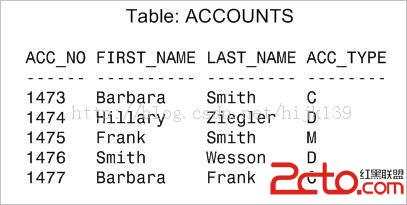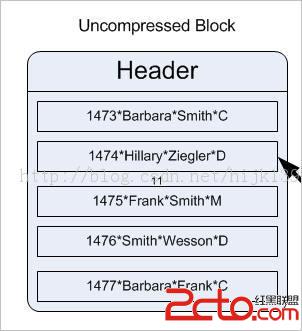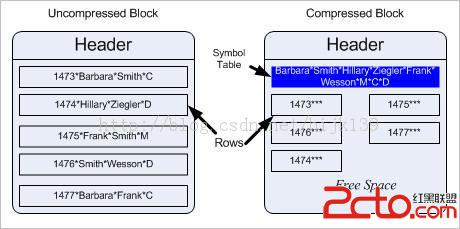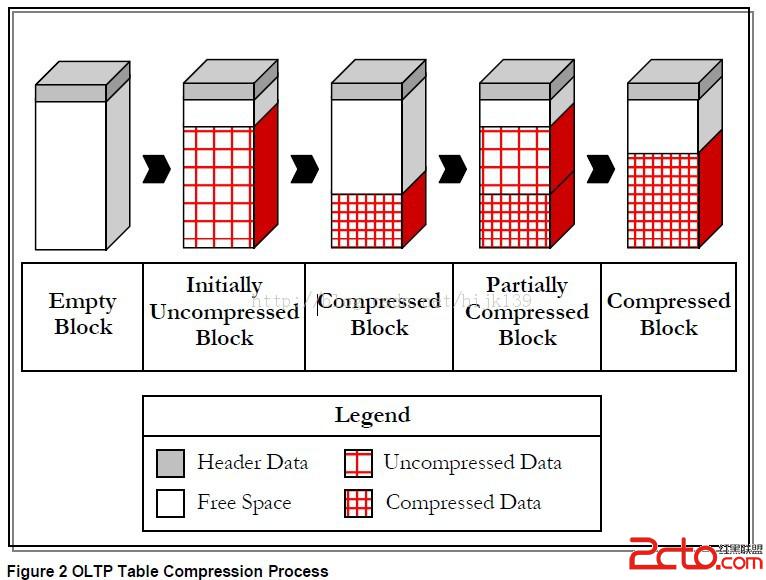oracle壓縮技術分為基本表壓縮(basic table compression),OLTP表壓縮(OLTP table compression),索引壓縮(index compression)和混合列壓縮(hybrid columnar compression (HCC))。
basic compression從9i開始推出,是oracle的默認壓縮方式。OLTP compression是11g開始推出,支持所有類型的DML操作的數據壓縮。壓縮會節省磁盤空間,但可能會增加CPU資源的消耗。本文主要討論常用的basic和LTOP壓縮,索引壓縮和HCC可以參考oracle其它文檔。表壓縮技術適合OLAP系統和OLTP系統中數據變化很小的歷史表,不適合頻繁DML操作的表
以OLTP壓縮為例,引用參考文檔4的說明,原理如下
請看一個 ACCOUNTS 表,它包含以下記錄:

在數據庫內部,假定一個數據庫塊包含上述所有行。

解壓縮的塊看上去是這樣的:記錄中的所有字段(列)都包含數據。壓縮此塊時,數據庫首先計算在所有行中發現的重復值,將這些值移出行外,然後將其放在塊的頭部附近。行中的這些重復值將被替換為一個表示其中每個值的符號。從概念上講,它看上去如下圖所示,您可以看到壓縮前後的塊。

注意這些值是如何從行中取出並放入頂部稱為“符號表”的特殊區域中的。列中的每個值都被分配一個符號,此符號將替代行內的實際值。由於符號所占空間小於實際值,因此記錄大小也遠遠小於初始值。行中的重復數據越多,符號表和塊越緊湊。
由於壓縮作為觸發事件發生,而不是在插入行時發生,因此在正常的 DML 進程中壓縮對性能沒有任何影響。壓縮被觸發後,對 CPU 的需求肯定會變得很高,但在其他任何時間 CPU 影響都為零,因此壓縮也適用於 OLTP 應用程序,這是 Oracle Database 11g 中壓縮的平衡點。
除了減少空間占用外,壓縮數據還將縮短網絡傳輸時間、減少備份空間,並使在 QA 和測試中維護生產數據庫的完整副本變得切實可行。
下面通過具體的實驗來看basic壓縮和OLTP壓縮的效果和異同點。
basic compression的6組實驗,來比較各種情況下的表壓縮
sys@MS4ADB3(dtydb5)> select count(*)from test;
COUNT(*)
----------
50000
-- 1.Baseline CTAS
create table t1 tablespace users
as
select * from test where rownum <=50000;
-- 2.CTAS with basic compression enabled
create table t2 compress basic tablespaceusers
as
select * from test where rownum <=50000;
-- 3.Normal insert into empty table defined as compressed
create table t3 compress basic tablespaceusers
as
select * from test where rownum = 0;
insert into t3 select * from test whererownum <= 50000;
-- 4.Direct path insert into empty table defined as compressed
create table t4 compress basic tablespaceusers
as
select * from test where rownum = 0;
insert /*+append*/ into t4 select * fromtest where rownum <= 50000
-- 5.CTAS without compression, then change to compressed
create table t5 tablespace users
as
select * from test where rownum <=50000;
alter table t5 compress basic;
--- 6. table move compress create table t6 tablespace users as select * from test where rownum <=50000; alter table t6 move compress basic;對表做表分析
execdbms_stats.gather_table_stats('SYS','T1');
execdbms_stats.gather_table_stats('SYS','T2');
execdbms_stats.gather_table_stats('SYS','T3');
execdbms_stats.gather_table_stats('SYS','T4');
execdbms_stats.gather_table_stats('SYS','T5');
execdbms_stats.gather_table_stats('SYS','T6');
查詢表占用空間情況
sys@MS4ADB3(dtydb5)> select table_name,blocks, pct_free , compression,compress_for
2 from user_tables
3 where table_name in('T1','T2','T3','T4','T5','T6');
TABLE_NAME BLOCKS PCT_FREE COMPRESSION COMPRESS_FOR
---------------------------------------------------------------------- ---------- ---------------- ------------------------
T1 666 10 DISABLED
T2 204 0 ENABLED BASIC
T3 622 0 ENABLED BASIC
T4 204 0 ENABLED BASIC
T5 666 10 ENABLED BASIC
T6 204 0 ENABLED BASIC
sys@MS4ADB3(dtydb5)> selectsegment_name,bytes/1024 K from dba_segments where segment_name in('T1','T2','T3','T4','T5','T6');
SEGMENT_NA K
--------- ----------
T1 6144
T2 2048
T3 5120
T4 2048
T5 6144
T6 2048
結果分析:
從上可以看出,
basic compression
在CATS,insert /*+append*/和move compress操作會對數據進行壓縮。而alter table compress操作會修改表的壓縮屬性,但不會對已有數據進行壓縮,對壓縮表做普通的insert操作也不對對數據進行壓縮。壓縮表的PCT_FREE為0,說明oracle設計基本壓縮表的目的就是認為此類表以後會很少修改
使用OLTP壓縮分別做以下6組實驗
-- 1. Baseline CTAS create table t21 tablespace users as select * from test where rownum <= 50000; -- 2. CTAS with OLTP compress enabled create table t22 compress for OLTP tablespace users as select * from test where rownum <= 50000; -- 3. Normal insert into empty table defined as compressed create table t23 compress for OLTP tablespace users as select * from test where rownum = 0; insert into t23 select * from test where rownum <= 50000; -- 4. Direct path insert into empty table defined as compressed create table t24 compress for OLTP tablespace users as select * from test where rownum = 0; insert /*+append*/ into t24 select * from test where rownum <= 50000; -- 5. CTAS without compression, then change to compressed create table t25 tablespace users as select * from test where rownum <= 50000; alter table t25 compress for OLTP; --- 6. table move compress create table t26 tablespace users as select * from test where rownum <= 50000; alter table t26 move compress for OLTP;表分析
exec dbms_stats.gather_table_stats('SYS','T21');
exec dbms_stats.gather_table_stats('SYS','T22');
exec dbms_stats.gather_table_stats('SYS','T23');
exec dbms_stats.gather_table_stats('SYS','T24');
exec dbms_stats.gather_table_stats('SYS','T25');
exec dbms_stats.gather_table_stats('SYS','T26');
表占用空間的大小
sys@MS4ADB3(dtydb5)> select table_name,blocks, pct_free , compression, compress_for
2 from user_tables
3 where table_name in ('T21','T22','T23','T24','T25','T26');
TABLE_NAME BLOCKS PCT_FREE COMPRESSION COMPRESS_FOR
------------------------------------------------------------ ---------- ---------- ---------------- ------------------------
T21 666 10 DISABLED
T22 225 10 ENABLED OLTP
T23 370 10 ENABLED OLTP
T24 225 10 ENABLED OLTP
T25 666 10 ENABLED OLTP
T26 225 10 ENABLED OLTP

轉化為壓縮表的3方法
1. ALTER TABLE … COMPRESS FOR OLTP
此方法對現有數據不壓縮,對以後的DML語句相關數據進行OLTP壓縮
2. Online Redefinition (DBMS_REDEFINITION)
對現有和以後的數據均壓縮。使用DBMS_REDEFINITION可以在線對表進行操作,可以使用並行操作。分區表的global index是個例外,需要在線重定義之後重建索引
3. ALTER TABLE … MOVE COMPRESS FOR OLTP
對現有和以後的數據均壓縮。在move過程中,會對表加排它(X)鎖,DML操作會被阻塞,可以使用並行提高性能。move操作會導致索引失效,因此move之後需要重建索引。move操作可以改變segment的表空間